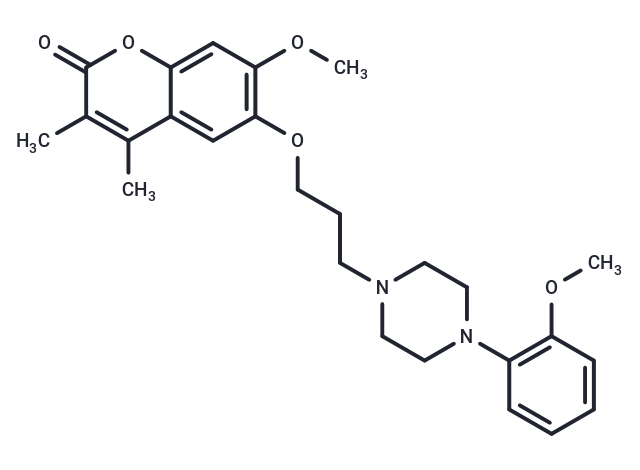Shopping Cart
Remove All Your shopping cart is currently empty
Your shopping cart is currently empty
Ensaculin (Anseculin), a novel benzopyrone partially substituted with piperazine, showed memory-enhancing effects in passive and conditioned avoidance paradigms in normal and artificially amnesic rodents. It showed neuroprotective activity in a model of NMDA toxicity and neurotrophic effects in primary cultured rat brain cells.Ensaculin can be used for the treatment of dementia.

| Pack Size | Price | USA Warehouse | Global Warehouse | Quantity |
|---|---|---|---|---|
| 1 mg | $128 | In Stock | In Stock | |
| 5 mg | $320 | In Stock | In Stock | |
| 10 mg | $470 | In Stock | In Stock | |
| 25 mg | $772 | In Stock | In Stock | |
| 50 mg | $1,080 | In Stock | In Stock | |
| 100 mg | $1,460 | - | In Stock | |
| 500 mg | $2,920 | - | In Stock |
| Description | Ensaculin (Anseculin), a novel benzopyrone partially substituted with piperazine, showed memory-enhancing effects in passive and conditioned avoidance paradigms in normal and artificially amnesic rodents. It showed neuroprotective activity in a model of NMDA toxicity and neurotrophic effects in primary cultured rat brain cells.Ensaculin can be used for the treatment of dementia. |
| Targets&IC50 | D2:16.6 nM, D3:27.7 nM, D4:277 nM, α1A-adrenoceptor:4.7 nM, α1B-adrenoceptor:9.3 nM, α:>100 nM, 5-HT1A:8 nM, 5-HT2:>100 nM |
| In vivo | Ensaculin (0.1, 1 and 10 mg/kg; i.p.; Wistar rats; 20 min after the onset of glutamate perfusion) significantly antagonized the formation of 2,3-DHBA, to values of 60.5% and 56.7% of control levels, respectively. Ensaculin may be useful in the treatment of neurodegenerative disorders associated with elevated hydroxyl free radicals and excitotoxicity.[1] |
| Synonyms | Anseculin |
| Molecular Weight | 452.54 |
| Formula | C26H32N2O5 |
| Cas No. | 155773-59-4 |
| Smiles | CC=1C=2C(=CC(OC)=C(OCCCN3CCN(CC3)C4=C(OC)C=CC=C4)C2)OC(=O)C1C |
| Color | White |
| Appearance | Solid |
| Storage | Powder: -20°C for 3 years | In solvent: -80°C for 1 year | Shipping with blue ice/Shipping at ambient temperature. | ||||||||||||||||||||||||||||||
| Solubility Information | DMSO: 42.6 mg/mL (94.14 mM), Sonication is recommended. | ||||||||||||||||||||||||||||||
Solution Preparation Table | |||||||||||||||||||||||||||||||
DMSO
| |||||||||||||||||||||||||||||||
| Size | Quantity | Unit Price | Amount | Operation |
|---|

Copyright © 2015-2026 TargetMol Chemicals Inc. All Rights Reserved.